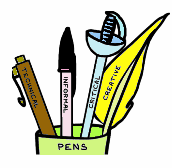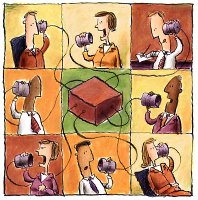 Starting Points
Starting PointsTake a day in your life. For example, yesterday.
Think of all the things you did on that day which involved some kind of writing, in any language. Make a list and try to recall as much as you can of the situations in which you wrote.
What were you doing? Who were you writing to? Why were you writing?
The chances are that on that day you engaged in many different acts of writing. You may have written continuous prose in the form of an essay or a report. This is probably what most of us think of when the word 'writing' is mentioned.
But you may also have written in many other ways: letters, emails, a blog, an online discussion forum, text messages, instant messages (MSN etc), a shopping list, a postcard (if you are on holiday). Even a diary, poetry, or (you never know) your life story.
 Writing Situations
Writing SituationsWhen you look closely at your everyday life you will probably find a lot of writing going on, often in connection with other technologies. Each act of writing will be slightly different - according to the situation you are in.
One way in which we can define writing situations is to consider the audience, content and purpose:
The writing situation depends on:
* the people you are communicating with (AUDIENCE)
* the topics you are writing about (CONTENT)
* the reasons why you are writing (PURPOSE)
When teaching 'writing' to children we need to bear in mind this diversity of situations. Written language is not just a feature of literacy in school. It is also a feature of social communication and personal lives.
As we saw in the first workshop, writing can be used for many purposes:
* to communicate a message
* to start or build (or even repair!) a relationship
* to persuade and promote
* to record
* to express ideas
* to work out our own thoughts
* to present ourselves to others
* to display knowledge
* to pass exams
Writing: Skill or Practice?
The chances are that even young primary-age children will use writing in some way outside school, often in connection with drawing, and of course see others writing all around them. Many children will have experience of writing text messages and emails before they learn formal writing at school. In these situations they are learning a skill, but also taking part in a social practice.
When teaching writing we must bear in mind that we are not just teaching a formal skill based on grammar. Writing is a formal skill and it does involve grammar; but it is also a set of practices.
Does the skill come first, and the practice later? Or are skill and practice always combined?
Audience and Purpose
It is useful to think of writing as a resource for communication in situations, therefore involving both skill and practice. The audience, content and purpose are not clear in all situations. In school, for example, children usually have to write for their teacher as the main audience. But they may also have to write for an unknown audience, such as an examiner.
The purpose of writing may change in subtle ways. When writing for a teacher children may see the purpose of their writing as communication or as a way of getting feedback. In a test or exam the situation changes. Their writing becomes a kind of display of ability or evidence, and not real communication. Children who do well in exams are often the ones who understand this changed situation. They recognise that the test is not the same practice of writing as, say, writing to their teacher or a friend.
 Some Vocabulary for Discussing 'Writing'
Some Vocabulary for Discussing 'Writing'Here are fourteen terms we used in the first workshop to discuss writing. Which of these terms would you use to describe what you were doing on your typical day? What other terms also come to mind?
Writer, Text, Situation, Genre/Text Type
Language, Community, Skill,
Style, Voice, Creativity, Topic,
Audience, Power, Communication
Approaches to teaching writing will find a place for all or most of these words, but the ways in which they are related will differ. Most approaches, for example, will give the writer and the writer's creativity a high value. But they will differ about how the writer's creativity is related to genre or to skill. Similarly, different pedagogical (= teaching) approaches will define these key words - especially words like power and style - in different ways.
Images of Writing
In the workshop we looked at some metaphors and images to answer the question: What is Writing? Here are some examples.
Writing is....

a way of thinking
 a unique talent
a unique talenta sign of knowledge
an escape
a commodity
Can you think of more images of writing?







